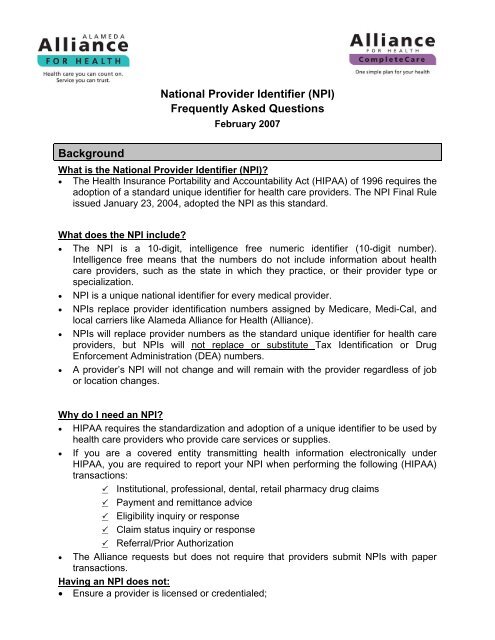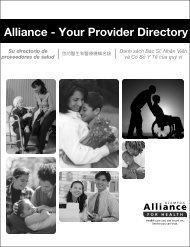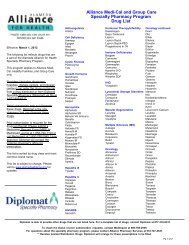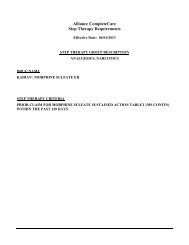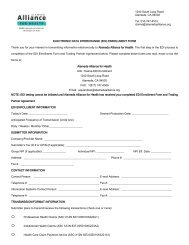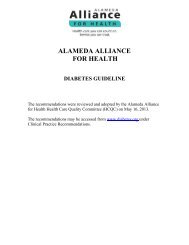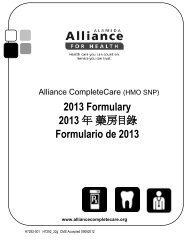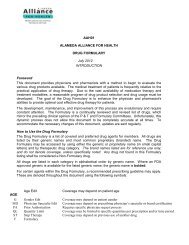NPI - Alameda Alliance for Health
NPI - Alameda Alliance for Health
NPI - Alameda Alliance for Health
Create successful ePaper yourself
Turn your PDF publications into a flip-book with our unique Google optimized e-Paper software.
Background<br />
National Provider Identifier (<strong>NPI</strong>)<br />
Frequently Asked Questions<br />
February 2007<br />
What is the National Provider Identifier (<strong>NPI</strong>)?<br />
• The <strong>Health</strong> Insurance Portability and Accountability Act (HIPAA) of 1996 requires the<br />
adoption of a standard unique identifier <strong>for</strong> health care providers. The <strong>NPI</strong> Final Rule<br />
issued January 23, 2004, adopted the <strong>NPI</strong> as this standard.<br />
What does the <strong>NPI</strong> include?<br />
• The <strong>NPI</strong> is a 10-digit, intelligence free numeric identifier (10-digit number).<br />
Intelligence free means that the numbers do not include in<strong>for</strong>mation about health<br />
care providers, such as the state in which they practice, or their provider type or<br />
specialization.<br />
• <strong>NPI</strong> is a unique national identifier <strong>for</strong> every medical provider.<br />
• <strong>NPI</strong>s replace provider identification numbers assigned by Medicare, Medi-Cal, and<br />
local carriers like <strong>Alameda</strong> <strong>Alliance</strong> <strong>for</strong> <strong>Health</strong> (<strong>Alliance</strong>).<br />
• <strong>NPI</strong>s will replace provider numbers as the standard unique identifier <strong>for</strong> health care<br />
providers, but <strong>NPI</strong>s will not replace or substitute Tax Identification or Drug<br />
En<strong>for</strong>cement Administration (DEA) numbers.<br />
• A provider’s <strong>NPI</strong> will not change and will remain with the provider regardless of job<br />
or location changes.<br />
Why do I need an <strong>NPI</strong>?<br />
• HIPAA requires the standardization and adoption of a unique identifier to be used by<br />
health care providers who provide care services or supplies.<br />
• If you are a covered entity transmitting health in<strong>for</strong>mation electronically under<br />
HIPAA, you are required to report your <strong>NPI</strong> when per<strong>for</strong>ming the following (HIPAA)<br />
transactions:<br />
Institutional, professional, dental, retail pharmacy drug claims<br />
Payment and remittance advice<br />
Eligibility inquiry or response<br />
Claim status inquiry or response<br />
Referral/Prior Authorization<br />
• The <strong>Alliance</strong> requests but does not require that providers submit <strong>NPI</strong>s with paper<br />
transactions.<br />
Having an <strong>NPI</strong> does not:<br />
• Ensure a provider is licensed or credentialed;
• Guarantee payment by a health plan;<br />
• Enroll a provider in a health plan;<br />
• Turn a provider into a covered provider; and<br />
• Require a provider to conduct HIPAA transactions.<br />
Action Items<br />
How can I obtain an <strong>NPI</strong>?<br />
• Providers can apply online at the National Plan and Provider Enumeration System<br />
(NPPES) Web site at www.nppes.cms.hhs.gov.<br />
• Providers can apply via paper application and mail it to the Enumerator, Fox<br />
Systems Inc., at:<br />
<strong>NPI</strong> Enumerator<br />
P.O. Box 6059<br />
Fargo, ND 58108-6059<br />
o<br />
Fox Systems Inc. can be contacted directly at 1-800-465-3203 or<br />
www.foxsys.com/npi.htm.<br />
Who do I give my <strong>NPI</strong> to once I obtain it?<br />
• Report your <strong>NPI</strong> to the <strong>Alliance</strong> as soon as possible, but no later than May, 23,<br />
2007, to Provider Services at (510) 747-4510. You can also send a fax to (510) 747-<br />
4508, or email providerservices@alamedaalliance.org.<br />
• Report your <strong>NPI</strong> to Medi-Cal by March 1, 2007, to www.medi-cal.ca.gov.<br />
When do I start using my <strong>NPI</strong>?<br />
• The <strong>Alliance</strong> will accept and store your <strong>NPI</strong> now. However, by May 23, 2007, you<br />
must use your <strong>NPI</strong> when submitting electronic transactions. The <strong>Alliance</strong> will<br />
request, but not require <strong>NPI</strong> on paper claims.<br />
• Providers should start phasing out use of older claim <strong>for</strong>ms and begin using the new<br />
CMS-1500 and UB -04 claims <strong>for</strong>ms effective May 23, 2007.<br />
If I do not report my <strong>NPI</strong> to the <strong>Alliance</strong> or other carriers what will happen?<br />
• Failure to report your <strong>NPI</strong> to the <strong>Alliance</strong> <strong>for</strong> electronic transactions is a HIPAA<br />
violation and may also result in claims payment delays.<br />
ELIGIBILITY<br />
Who can apply <strong>for</strong> the <strong>NPI</strong>?<br />
• All health care providers (e.g., physicians, suppliers, hospitals, and others) are<br />
eligible <strong>for</strong> <strong>NPI</strong>s. <strong>Health</strong> care providers are individuals or organizations that<br />
render health care.<br />
• All health care providers who are HIPAA-covered entities, whether they are<br />
individuals (such as physicians, nurses, dentists, chiropractors, physical<br />
therapists, or pharmacists) or organizations (such as hospitals, home health<br />
agencies, clinics, nursing homes, residential treatment centers, laboratories,<br />
ambulance companies, group practices, HMOs, suppliers of durable medical<br />
equipment, pharmacies, etc.) must obtain an <strong>NPI</strong> to identify themselves in HIPAA
standard transactions.<br />
What is a HIPAA-covered health care provider?<br />
• A health care provider who transmits any health in<strong>for</strong>mation in electronic <strong>for</strong>m in<br />
connection with a transaction <strong>for</strong> which the Secretary of <strong>Health</strong> & Human Services<br />
(HHS) has adopted a standard, even if the health care provider uses a business<br />
associate to do so. To access the tool to help establish whether one is a covered<br />
entity, visit:<br />
http://www.cms.hhs.gov/HIPAAGeninfo/Downloads/CoveredEntitycharts.pdf.<br />
Is a sole proprietor/sole proprietorship an individual or an organization?<br />
• A sole proprietor/sole proprietorship is an individual and is eligible <strong>for</strong> a single <strong>NPI</strong>.<br />
The sole proprietor must apply <strong>for</strong> the <strong>NPI</strong> using his or her own SSN, not an EIN<br />
even if he/she has an EIN. Because a sole proprietor/sole proprietorship is an<br />
individual, he/she cannot be a subpart and cannot designate subparts.<br />
What is a subpart?<br />
• A subpart is a component of an organization provider that furnishes health care and<br />
is not itself a legal entity.<br />
A subpart might:<br />
‣ Own its standard transactions<br />
‣ Be at the same or different address than organization provider “parent”<br />
‣ Be certified separately from the organization provider “parent” by the State<br />
‣ Furnish services of a type different from that of the organization provider<br />
A subpart cannot be a person and a person cannot have subparts. An organization can<br />
decide if it has “subparts” that need their own <strong>NPI</strong>s.<br />
What is a taxonomy code?<br />
• The <strong>Health</strong> Care Provider taxonomy code set is a collection of unique alphanumeric<br />
codes, ten characters in length. The taxonomy code identifies a provider’s specialty<br />
category and must be entered on the <strong>NPI</strong> application. Providers may have one or<br />
more values associated with them. When determining what value or values to<br />
choose, the provider needs to review the requirements of the trading partner with<br />
which the value(s) is being used. Providers must choose taxonomy associated with<br />
their provider type/specialty.<br />
• Upon implementation of the <strong>NPI</strong>, providers will be required to submit the billing<br />
provider’s taxonomy code on their claim. Additional taxonomy in<strong>for</strong>mation, including<br />
a complete list of taxonomy codes, is available at www.wpc-edi.com/taxonomy.<br />
• To identify subparts of their facility, only institutional providers are required to use<br />
their taxonomy code, if they currently bill Medicare using more than one legacy<br />
Medicare identifier.<br />
Who cannot receive an <strong>NPI</strong>?<br />
• Any entity that does not meet the definition of a “health care provider” at 45 CFR<br />
160.103, which would include billing services, value-added networks, re-pricers,<br />
health care clearinghouses, non-emergency transportation services, and others.


